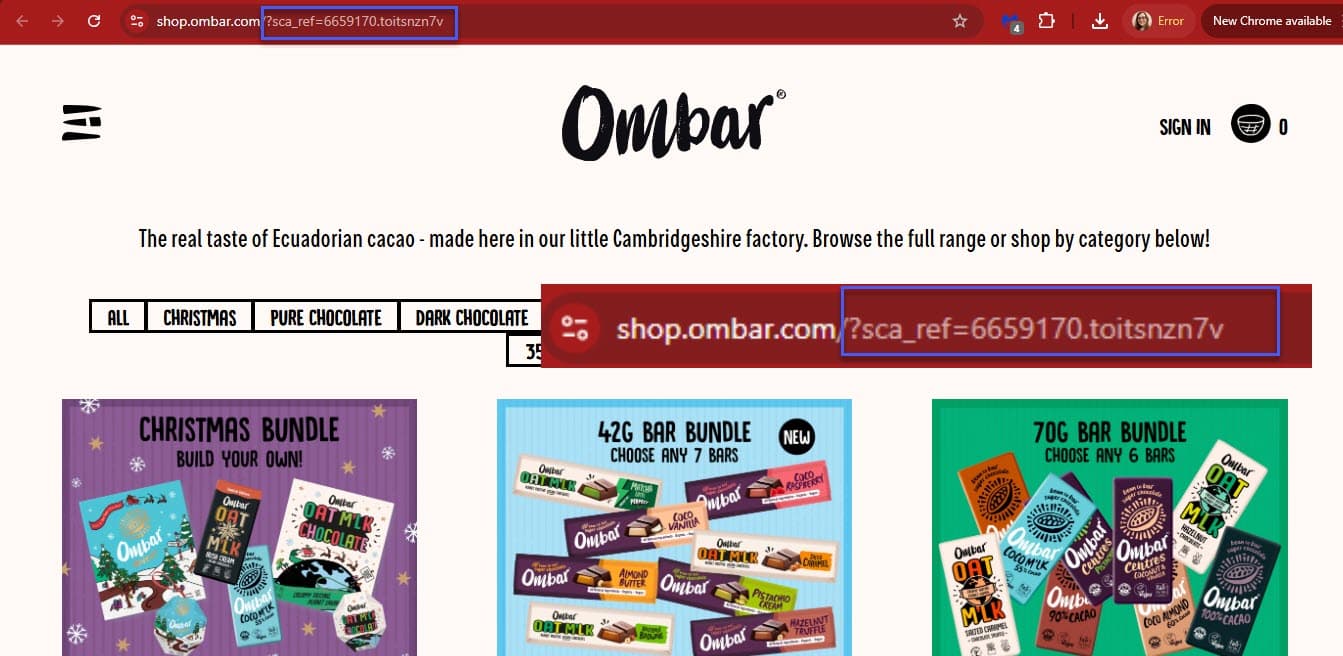Many businesses turn to affiliate marketing because it’s a low-risk digital marketing strategy, and inexpensive in that businesses only pay commissions for successful sales.
At the heart of starting an affiliate marketing program is the affiliate link. These unique links are how you’ll track the clicks and sales generated by the affiliate’s efforts, and determine how much you’ll need to pay out in commissions.
This step-by-step guide covers how to create affiliate links, so your business can run and track a successful affiliate marketing campaign.
What is an affiliate link?
An affiliate link is a URL that directs to a brand’s website, and that contains a unique tracking ID.
Each content creator will have their own unique identifier, or affiliate tracking ID, within their link. Usually, the ID is a set of numbers, but sometimes, the ID is customized with the affiliate’s name or username. This ID lets a business accurately attribute sales to the right affiliate, and track the sales each affiliate drives in real time.
When someone clicks on an affiliate link and makes a purchase, the creator who “owns” the link automatically earns an affiliate commission. And even if they don’t purchase, the link still attributes the click to the affiliate so the brand knows who drove the traffic.
Here are some examples of affiliate links (notice the affiliate tracking IDs after the question marks in the links):


To recap:
- Whenever someone clicks on the affiliate link and makes a purchase, the tracking ID in the link attributes the purchase to the affiliate.
- This lets your business view the amount of traffic or clicks the affiliate is bringing in, even if traffic does not result in a purchase.
- When a purchase is made through an affiliate link, the affiliate automatically receives a cash commission, as a reward for driving the sale.
How to set up affiliate links in 5 simple steps
Creating affiliate links is a fairly simple process that can be done for any affiliate program. This is true whether you choose to give each affiliate their own custom link, or use auto-generated links. Here’s how to create affiliate links, step by step.
Step 1: Choose the right affiliate program software
Before you begin, you’ll need an affiliate marketing tool to help you set up links and track affiliate sales. This will either be affiliate software or an existing affiliate network.
Affiliate software (also called an affiliate platform) is the easiest way to create affiliate links, track affiliates’ sales, optimize your results, and maintain full control over your affiliate program and its data.
To choose the right software, make sure it offers:
- Flexible affiliate link generation: Does the software let you customize the link how you wish, and attach discounts for the people who click on it? Can your affiliate links register impressions, qualified leads, and sales?
- Commission tracking and payment processing: Can you track affiliate sales and commissions owed to each affiliate, as well as process commission payments? Can you customize commission structures to account for tiered rewards, recurring rewards, or limited-time bonuses if you choose? Do you have a range of options for cash payouts?
- Performance tracking and reporting: Does the software give you an in-depth view of how the program performs, with advanced metrics, customizable performance reports, and easy data analysis?
- Easy integrations: Can you integrate the software with your CRM (and other software in your existing tech stack), so any data collected through affiliate links can pass seamlessly to other programs?
- Complete customization: Can you fully customize your affiliate program, including your commission structure, branding, portal, and how you communicate with affiliates? Affiliate networks (and marketplace platforms that operate like affiliate networks) don’t allow for this.
With affiliate software, you’ll be able to change up the program as needed, whether you want a standalone affiliate site or a widget. The right affiliate software will allow you to create affiliate links and run an entire affiliate program from start to finish.
It all starts with the software. Once you have that figured out, you can hunker down and truly get started creating affiliate links.
Step 2: Decide on the commission rules and cookie length
Coming up with the URL parameters is one thing. Deciding what that link does is another. Your link not only needs to be able to tie an affiliate to it, but it also needs to accommodate the different variables you choose.
You’ll need to set rules for all the affiliate links before you create and distribute them to affiliates. This is where software comes in. Software will apply them automatically to all links once a rule is set.
Some things to consider:
- What should be tracked? What counts as the conversion(s) you want the link to track? Usually, this is a purchase, but for B2Bs, it could be both a lead qualification and a purchase.
- The conversion is the action registered by the link that triggers the commission payout to affiliates.
- When will a commission get paid? What commissions will an affiliate earn when the link registers a conversion?
- Set these with your software – along with any criteria or days that an affiliate has to wait before the commission is paid.
- How long should the cookie length be? In other words, how long after an affiliate link click will a purchase be attributable to an affiliate?
- You can easily set these parameters with affiliate software.
- You can also set whether the first affiliate link click or last link click gives the affiliate credit, if someone clicks two or more different affiliate links when the tracking cookie is active.
- Cookie length and rules should be the same for all affiliates in your program.
By adding these rules to your affiliate links, it will keep affiliates on track and help them stay within the rules of the affiliate program.
Step 3: Create the affiliate links
Now that you’ve decided on the right software and have your commission rules and cookie length figured out… you’re ready to actually start creating affiliate links. Let’s go through the process of how an affiliate link is created.
In most cases, affiliate links are only created once you form a partnership with an affiliate. It’s unlikely that you’ll have an existing list of links waiting to be assigned as new affiliates come in.
Here’s how to create affiliate links:
- Find an affiliate. First, approve affiliates for your program and register them with the software. Then, the software will create a unique affiliate link for them upon registering them in your program.
- Decide on the link destination. Before you can create a link, you need to decide on the destination (the webpage where the affiliate link points to).
- Will it lead to a custom landing page? To a given product page? Or simply to your store page?
- Once you’ve set the destination, the software can automatically create multiple links – for different affiliates – to the same destination (if you want all affiliates to promote the same page).
- Come up with a link formula. Often, affiliates will want a custom affiliate link, with part of their name, affiliate website, or other identifying information inside.
- Usually, affiliate software will add that identifying information automatically. For example, you can have the software pull the affiliate’s first name or social media handle to use as the custom link when affiliates first sign up.
- If you wish, you can use affiliate software to add a shortcode as a further custom identifier.
- If you have to change the code, you can always edit individual codes at any time. For example, if a blogger was originally assigned a code using their blog name, but changes the title of their blog, you can edit this specific code to reflect the new blog name if needed.
Step 4: Associate coupons with the link (if you want)
Not all affiliate links will double as coupons. But, to encourage conversions, you may want to offer affiliates’ audiences a discount towards their purchase on your site.
One of the top affiliate best practices is to have affiliates give out coupons to their audience, which will activate when someone clicks the affiliate link.
This will encourage more sales for you – and in turn, generate more commissions for the affiliate. Your affiliate will want to share or post their affiliate link in more places, and their audience may be more enticed to click the link.
Remember these tips when coupling affiliate links and coupons:
- Make the process simple. Referral Rock affiliate software lets you set a discount to activate whenever the affiliate link is clicked. This will automatically apply if the person who clicked the link makes a purchase (and automatically tie the sale to the affiliate).
- Simple means convenient. By including the coupon code in with the affiliate link, both affiliates and leads will appreciate the convenience. No need to remember the code.
If you want to generate your own unique coupon codes, look no further than our coupon code generator>
Step 5: Distribute the links
Once you accept an affiliate, you’ll need to provide them with all of your program information. When you give affiliates access to their unique link, this is also an important time to brief them about the program as a whole and set them up for success.
When distributing links, there are a few things to keep in mind:
- Use an onboarding email. This email will provide all relevant information about the program. A link to the affiliate portal and their unique affiliate link are two items that should be included.
- Materials about the program. Along with the affiliate link and portal access, provide marketing assets, templates, and program materials (as attachments or through the portal). This is a great moment to brief the affiliate on how they can and can’t promote their affiliate link.
- Explain tracking. When you distribute affiliate links, it’s best to show affiliates how they can track the purchases made via their link – and use their portal as a whole.
- Explain payments. How will affiliates be paid when their affiliate link clicks result in purchases (via PayPal? Through direct deposit?) And how often will they receive commission payouts?
- Give marketing tips to help them promote the affiliate links, whether that’s through the portal, in the email, through a webinar link, or elsewhere.
Use software, not a network, to create affiliate links
Why is software so important for generating affiliate links? An existing affiliate network may seem like an easier option for starting an affiliate campaign. But networks bring far more drawbacks than benefits. There are many reasons why you should stay away from affiliate networks, and instead rely on affiliate software.
Here’s why you shouldn’t use an affiliate network:
- Reduced control. Using an affiliate network may seem tempting because it finds and enrolls affiliates for you… but this isn’t the best way to make affiliate links. When using an affiliate network, you are subject to their rules and regulations. This limits your ability to customize your affiliate program to suit your needs. Additionally, you may not have control over the affiliates that are promoting your products or services, which can impact your brand reputation.
- Lack of transparency. You can’t reap all the benefits of affiliate links with a network, because networks control affiliate data and don’t give you access to the crucial pieces. This can make it difficult to track the success of your affiliate program and make informed decisions about future marketing efforts.
- Limited customization. Affiliate networks also don’t let you customize affiliate links (and other parts of your program) however you wish.
- More or higher fees. Affiliate networks often charge fees for their services, which can eat into your profits. These fees may include setup fees, monthly fees, and transaction fees, among others. In addition, affiliate networks may take a percentage of your sales for themselves, which means that you may need to pay smaller commissions to your affiliates than if you were running your own affiliate program.
Why use an affiliate software instead?
- More control. Software gives you full control over affiliate links and affiliate data, so you’ll always know your ROI. You also have control over your affiliates, link structure, and reward distribution.
- More customization. Software lets you customize your affiliate links – and other parts of the program – however you wish.
- Stronger affiliate base. While affiliate networks can provide access to a large pool of affiliates, they may not be the affiliates that you want to promote your products or services. By using software, you have complete control over which affiliates you let into your program. Recruit your own customers and fans without being forced to give them to the network.
- Cost-efficient. You won’t have a middleman take a cut of your sales, so you’ll enjoy higher profits from affiliates. Also, you have more leeway to offer higher commissions. This may leave your affiliates feeling more satisfied and eager to keep promoting your business.
Clearly, affiliate software can give you more control, customization, and happier affiliates, so it’s the better choice to create affiliate links.
Set up affiliate links with Referral Rock
With Referral Rock affiliate software, you’ll get the most out of your affiliate links (and the rest of your affiliate program):
- Customize your links and tracking codes however you wish, and automatically distribute them to affiliates.
- Reward affiliates with any commission, including tiered, recurring, multi-step, and limited-time commissions.
- Set up PayPal payouts, Wise transfers, or custom bank transfers.
- Automatically pay out commissions when affiliate links register conversions.
- Create a custom portal for affiliates to access their links and track their own sales.
- Add coupon codes for affiliates’ audiences right into affiliate links.
- Get full visibility into your program’s KPIs thanks to robust affiliate link tracking.
- Integrate with 50+ tools, so information from affiliate links seamlessly passes to your CRM, ecommerce platform, and other software you already use.
- Work with a dedicated onboarding specialist to set up your program based on your needs.
Learn how Referral Rock can help you set up an affiliate program in days >
Affiliate link FAQ
Now that you get the gist of affiliate links, let’s dig a bit deeper. If you’ve still gor questions, we’re here to help.
How do links work in an affiliate program?
In an affiliate program, an online business or retailer offers an incentive to content creators and entrepreneurs (the “affiliates”) to promote their products, website, or services. The incentive is usually a commission on any resulting sales that the affiliate generates.
Here’s how affiliate links work in an affiliate program:
- A business provides the affiliate with a unique affiliate link that contains a tracking code to share within their content.
- Affiliates will place the link in content that they create on their own channels (usually in blogs, videos, and social media posts).
- This content could be product reviews, tutorials, and how-tos where the products can be used. Or, any other content that’s relevant to the brand and products – anywhere the links could fit naturally.
- When someone clicks on an affiliate’s link and makes a purchase, the responsible affiliate gets credited with the sale, and receives a cash commission.
The business will track any sales generated by each affiliate’s personal link. This allows the company to accurately calculate the commission rate owed to each affiliate and pay them accordingly. Affiliates can track their sales and earnings in their affiliate dashboard, which typically provides real-time data on clicks, conversions, and earned commissions.
Why do you need affiliate links?
Affiliate marketing is a win-win situation for both your business and the affiliates. Your business can reach a wider audience and increase sales through the affiliates’ marketing efforts. Meanwhile, affiliates can earn passive income by promoting products or services they believe in.
Affiliate links are the backbone of an affiliate program, so you’ll need them if you want to leverage affiliates in any way All of the tracking and reward payout elements of the program rely on the affiliate link.
Here are more details on why affiliate links are so beneficial for affiliate management:
- Performance insights. Links track which affiliates perform well, so you can easily identify top affiliates (and find out which affiliates may need more guidance).
- Lead generation. Affiliate links are another channel for driving traffic, which can help generate leads. People reading affiliates’ blogs, for example, may click on a link to your product mentioned in the blog – leading them directly to your site to purchase the product.
- Trackable influencers. Giving affiliate links to social influencers creates a reliable way to track their ROI. You can see which influencers are bringing in the most traffic and sales. Without affiliate links, it can be difficult to track the sales influencers generate.
- Creates trust. When affiliates place their affiliate link in relevant, high-quality content, their audience trusts what they have to say. Their audience is primed to purchase from you, leading to higher conversion rates.
- Instant rewards. Links allow for instant and accurate compensation of affiliates. Each time a link is clicked and a purchase is made, the affiliate is automatically paid as they are tied to the purchase.
So, if you are looking to start an affiliate program, remember the affiliate link ties everything together, and keeps things in smooth working order.
What are different types of affiliate links?
You can set up an affiliate link in a few different ways. However, there’s sometimes a bit of overlap between these. Here are the basic types of affiliate links:
- The standard affiliate link: The URL seen when the link is moused over/clicked on is the exact, long URL with all tracking parameters. Sometimes, with all of the tracking parameters displayed, the link can get quite long. But since the whole link is typically hyperlinked over a specific word or phrase, this usually isn’t an issue.
An example of a standard affiliate link from Amazon Associates, the Amazon affiliate program.
- The shortened affiliate link: The URL seen when the link is moused over/clicked on is a shortened version of the link, but still holds the tracking ID. If you’re not a fan of the standard (long) affiliate link, you may turn to this option as it looks tidy and neat.
- With Referral Rock’s Zapier integration, you can easily shorten affiliate link URLs.
Here’s what the above affiliate link might look like shortened. Notice the numbers that show the tracking ID.
- The discount affiliate link: When someone clicks on this link, a discount for the business’ website is activated in addition to the tracking parameters. A discount can be applied to both the standard or shortened type of link. The affiliate’s audience can take advantage of this discount when purchasing your product or service, without having to enter a coupon code manually.
This link looks similar to the shortened affiliate link, but it will activate a discount once someone clicks.
What destinations can affiliate links direct to?
Affiliate links can have different destination types, or webpages where you direct the affiliate’s audience to. Set your destinations based on your program goals – are you trying to generate purchases, or create warm leads first? And do you want affiliates to promote specific products, or your brand in general?
The most common affiliate link destinations are:
- A product page (“affiliate product links”)
- Your main store page
- Your homepage
- A custom landing page
With Referral Rock, the same affiliate can promote multiple different affiliate links with different destinations, depending on the offers they think would best resonate with their audience. All the offers automatically have the affiliate’s tracking parameters attached, for easy tracking and commission payouts.
Do affiliate links help your SEO?
Generally, affiliate links to your website don’t help search engine optimization directly, but don’t hurt it either. Affiliate links are meant to drive traffic to your site and generate warm leads and sales, not boost SEO.
If affiliate partners integrate the links into content in a natural, relevant way, though, they might help your SEO, as search engines will see the links as valuable. Of course, if affiliate links are tagged as nofollow, they can’t pass authority to your site by default.
Are affiliate links the same as referral links?
In many cases, the terms “affiliate link” and “referral link” are used interchangeably. However, there are some differences between the two.
Affiliate links and referral links operate the same way – both contain tracking codes that attribute sales back to the person who shared the link. But there are key differences in how these links are shared, who shares them, and what software is involved.
Affiliate links
An affiliate link is a unique URL that allows a content creator (affiliate) to promote the a brand’s products or services in their content. When someone who views the content clicks on an affiliate link and makes a purchase, the affiliate earns a commission or a percentage of the sale. Usually, the people who view the content and click the link are people the affiliate doesn’t know personally.
Referral links
A referral link, on the other hand, is a link that is used to directly refer a friend to a product or service. Referral links are used in referral programs, where existing customers are incentivized to refer new customers to a business. When a person clicks on a referral link and becomes a customer, the person who referred them may receive an incentive.
Here’s a deeper dive into the differences between referral and affiliate links:
| Who (shares them & sees them)? | |
| Affiliate links are shared by content creators (like bloggers and social media creators).Affiliate links are meant for an audience that the affiliate doesn’t know personally. | Referral links are shared by your customers (and sometimes even your employees).Referral links are directly shared with friends and family – people customers know personally. |
| Where (are they shared)? | |
| Affiliate links are shared in publicly available content, like blogs, social media posts, YouTube videos, email list newslettters, and TikTok videos. | Referral links are shared in direct emails, on social media platforms, or in personal messages/texts to customers’ friends and family. |
| How (are they created)? | |
| Affiliate links are created with affiliate program software. | Referral links are created with referral marketing software – although the right software (like Referral Rock) can run both types of programs and create both types of links. |
Wrap-up
An affiliate link is a unique tracking link that allows affiliates to promote a product or service and earn a commission for any resulting sales.
Thanks to software, creating affiliate links is a straightforward and rather easy process: add affiliates to your program, and then have the software automatically generate a unique tracking link for the affiliate.
If you’re looking to grow your business with an affiliate marketing strategy, and want to fully customize your affiliate links, learn more about building an affiliate program using Referral Rock.




